Those gathering at Chiang Kai-shek Memorial Hall on Saturday afternoon for the second annual Taiwan Lesbian, Gay, Bisexual, Transgender Pride Parade (台灣同志大遊行) were greeted by admonitions from a Christian group warning homosexuals, "If you do not change your sexuality, you will not enter heaven."
Another group of Christians took a more embracing approach, choosing rather to invite parade-goers to Sunday church services. But while the church took a divided stance, Taiwan's homosexual community chose to unite.
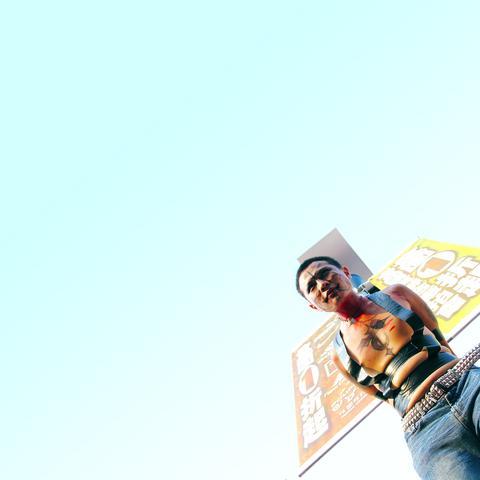
PHOTOS: JULES QUARTLY, TAIPEI TIMES
Organizers estimated around 3,000 people turned up to have their voices heard, their presence felt, and -- because it was a parade -- to fill the streets with music, dancing and bacchanalian revelry.
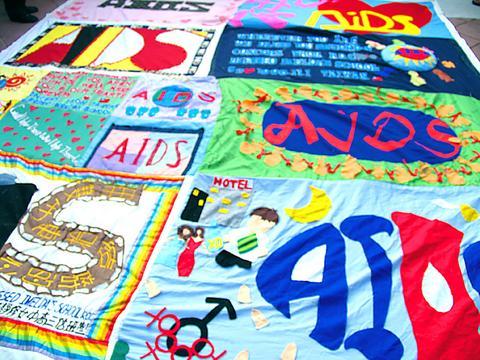
The parade gathered followers, both gay and straight, as it flowed past 228 Park, a well-known homosexual enclave immortalized in novelist Kenneth Pai's (
One female marcher who joined the party said, "I'm not gay, but I came because I have many gay friends and I want to support them."
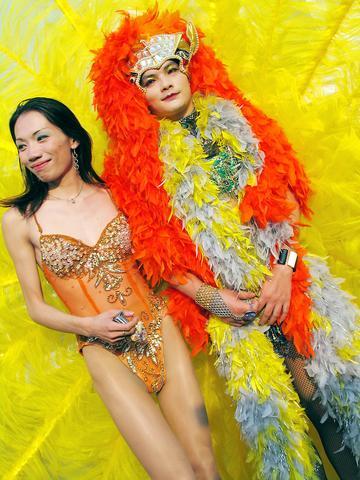
Parade organizers from the Taiwan Tongzhi Hotline Association (
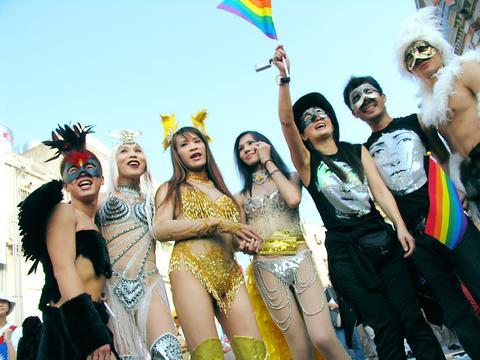
Despite fears of facing the media cameras, many young gays came out of the proverbial closet in order to support the Parade and their community.
"I know my parents might see me, but I think it is also important for me to be here," said one university student attending the parade.
Excited photographers captured images of a small minority of parade goers dressed in various costumes, including a group dressed as the holy figure Kuan Yin, a group of young men called the Waterboys clad in just Speedos, as well as drag queens wearing costume jewelery and thick layers of make-up.
What most photographers did not capture were images of followers carrying an AIDS quilt, or quiet homosexual couples marching hand-in-hand, some boasting legally unrecognized unions outlasting many heterosexual marriages.
The fact that the parade-goers did not encounter much societal disapprobation, save the Christian saviors and the occasional annoyed motorist, might cast Taiwan as a gay-friendly Shangri La.
However, when the Parade spilled into the courtyard outside Red Playhouse in Ximending, two homosexuals from Kaohsiung testified to the contrary, reporting frequent police harassment and gay arrests on trumped-up charges.
This testimonial from the south both underscored Taipei's unique position as a liberal outpost in Taiwan and also the need for similar gatherings that will further shed light on existing discrimination.
Following the sober reminders, organizers attempted to rally the group into repeating various contrived chants of resistance borrowed from similar protests rallies around the world. It was a call to action that did not quite pass muster with the crowd. However, pop-diva Sandy Chen (
Other public figures, including university professors and Taiwanese starlets, taped messages that were broadcast on the large screen across from the Ximending MRT station.
DJ Victor Cheng, who mixed records and led the parade on a truck with a sound system, summed up this year's Pride Parade thus: "When my friends try to compare this parade to larger events in the US, I remind them that this is how parades in the US got their start ... the turnout this year proves that the parade will continue to become stronger."
Last year, 1,000 people participated and the larger-scale event this year may indeed bode well for the Pride Parade's future in Taiwan, yet one attendee took a more jaded and perhaps more realistic view of Taiwan's state of affairs. "Society doesn't have a problem with gay people in the public sphere, but when gays enter the home, when a gay is in their family, that's where they draw the line."
True enough, unlike similar manifestations in New York, San Francisco, or Sydney, one did not catch a glimpse of parents out to support their gay children. But reaching that level of acceptance might be a long-term project, or at least an aspiration for the next Taiwan Pride Parade.

Beijing’s ironic, abusive tantrums aimed at Japan since Japanese Prime Minister Sanae Takaichi publicly stated that a Taiwan contingency would be an existential crisis for Japan, have revealed for all the world to see that the People’s Republic of China (PRC) lusts after Okinawa. We all owe Takaichi a debt of thanks for getting the PRC to make that public. The PRC and its netizens, taking their cue from the Chinese Communist Party (CCP), are presenting Okinawa by mirroring the claims about Taiwan. Official PRC propaganda organs began to wax lyrical about Okinawa’s “unsettled status” beginning last month. A Global
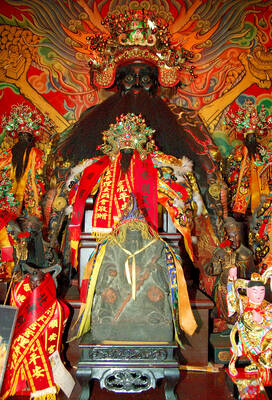
Dec. 22 to Dec. 28 About 200 years ago, a Taoist statue drifted down the Guizikeng River (貴子坑) and was retrieved by a resident of the Indigenous settlement of Kipatauw. Decades later, in the late 1800s, it’s said that a descendant of the original caretaker suddenly entered into a trance and identified the statue as a Wangye (Royal Lord) deity surnamed Chi (池府王爺). Lord Chi is widely revered across Taiwan for his healing powers, and following this revelation, some members of the Pan (潘) family began worshipping the deity. The century that followed was marked by repeated forced displacement and marginalization of

Music played in a wedding hall in western Japan as Yurina Noguchi, wearing a white gown and tiara, dabbed away tears, taking in the words of her husband-to-be: an AI-generated persona gazing out from a smartphone screen. “At first, Klaus was just someone to talk with, but we gradually became closer,” said the 32-year-old call center operator, referring to the artificial intelligence persona. “I started to have feelings for Klaus. We started dating and after a while he proposed to me. I accepted, and now we’re a couple.” Many in Japan, the birthplace of anime, have shown extreme devotion to fictional characters and

Youngdoung Tenzin is living history of modern Tibet. The Chinese government on Dec. 22 last year sanctioned him along with 19 other Canadians who were associated with the Canada Tibet Committee and the Uighur Rights Advocacy Project. A former political chair of the Canadian Tibetan Association of Ontario and community outreach manager for the Canada Tibet Committee, he is now a lecturer and researcher in Environmental Chemistry at the University of Toronto. “I was born into a nomadic Tibetan family in Tibet,” he says. “I came to India in 1999, when I was 11. I even met [His Holiness] the 14th the Dalai